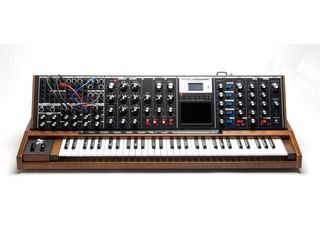PRESS RELEASE: Designed in celebration of the 40th anniversary of the Minimoog, the Minimoog Voyager XL is a sonic powerhouse that pays homage to important milestones in the Moog synthesizer legacy. It starts with the heart of a Minimoog. Fat oscillators and warm Moog filters give it that unmistakable Moog sound and the build quality and user interface design immediately let you know that you are playing a high-quality musical instrument.
The Minimoog Voyager XL features extensive front-panel patchability that harkens back to the original groundbreaking Moog modular synthesizers. The addition of a 4-channel CV mixer, 2-channel attenuator, lag processor and MIDI-synced LFO make this a sound design and analog control dream machine. From the current Voyager lineage, the XL inherits a 100% analog signal path with stable oscillators, patch storage, touch surface, pot mapping and extensive MIDI control functionality. To all this, add a ribbon controller and 61 note keyboard and you have a monster analog monosynth built on a 40 year legacy of sonic exploration.
Specification Summary
100% Analog Sound Engine
The MINIMOOG VOYAGER XL Synthesizer is a monophonic analog performance and production synthesizer. Based on the Minimoog Voyager sound engine, it incorporates virtually all of the sound resources and functions of the original Minimoog Model D and Voyager, with the addition of a number of exciting features from Moog's modular synthesizer legacy.
Keyboard
61-Note Velocity Sensitive Keyboard with after-pressure. Identical to the Voyager 44-note keyboard.
Ribbon Controller
A 500mm Ribbon Controller is located on the middle wooden rail of the Voyager XL. It's centerpoint is lined up with "middle-C" of the 61-note Keyboard. Outputs are sampled and available as CV-OUT (-5V to +5V) and GATE-OUT (0V to +5V).
(20) Control Voltage outputs
Keyboard Ptich, Velocity and Afterpressure; Touch Surface X, Y, and A (area); Pitch and Mod Wheel; MOD 1 and 2 signal (signal at Voyager MOD 1 input); - LFO - Triangle and Square wave Mod Wheel Mod Buss and Pedal/On Mod Buss output; Filter and Volume Envelope; Sample and Hold (Step and Smooth); Noise; Ribbon Controller CV Output (-5V to +5V)
(3) Gate outputs
Keyboard, Touch Surface, and Ribbon Controller
(3) 4-way Mults
(top jack is ring-powered)
(10) Control Voltage inputs
Envelope Rate; OSC Pitch; OSC Wave, Filter Cutoff, VCA Volume, VCA Pan, LFO Rate, MOD 1, MOD 2 and Sample and Hold
(4) Control Voltage inputs
ENV Release ON/OFF, ENV Gate input, LFO Sync ON/OFF, Sample & Hold Gate input
(2) Active Attenuators
Active Attenuators are identical to the VX-352 attenuators with the following difference: CHANNEL 1 is normalled to LFO 2 output. So, if nothing is connected to the Channel 1 input jack, the output of Channel 1 will be the attenuated version of the LFO 2 output.
CHANNEL 2 is normalled to RIBBON output. So, if nothing is connected to the Channel 2 input jack, the output of Channel 2 will be the attenuated version of the RIBBON controller.
EXPRESSION PEDALS can be connected to the Attenuator inputs (i.e. they are ring-powered inputs).
AMOUNT controls gain of -1 (CCW) to 1 (CW). Thus, the attenuators can create an inverted version of the waveform.
OFFSET control allows you to add a DC voltage of -5V to +5V to the input signal. The Attenuator output will be clipped to approximately +/-10V.
Four-Input Mixer
There are four inputs.
- Inputs 1 and 2 can be attenuated via front-panel knobs
- Inputs 1 and 3 can be controlled by Expression Pedals (i.e. ring-powered)
- Two output CV's (+) and (-) - DC offset can be added to signal via OFFSET knob
- Overall output of MIXER can be adjusted via the MASTER knob
Lag Processor
RISE and FALL time constants are adjustable from 1 ms to 1 second (middle is 100 ms).
LFO 2
A MIDI-syncable with a default frequency range is 0.02Hz (50 seconds) to 20Hz (0.05 seconds). This range was made to augment the current Voyager LFO which does not go slow-enough for some very slow modulations.
INPUTS: LFO 2 can be
- free-running (adjusted by the RATE knob on the front panel)
- MIDI SYNC from external MIDI clock - directly CLOCKED from a GATE CV via the front panel CLOCK jack
- controlled via external CV or Expression Pedal via the front panel RATE CV jack
- expanded control options via direct MIDI control (tbd
OUTPUTS: LFO 2 has two complementary LFO outputs labeled (+) and (-). In default mode, these are the same waveform 180 degrees out of phase. There will be more options available by direct MIDI control such as independent LFO waveforms / rates (tbd)
WAVEFORMS AVAILABLE FROM FRONT PANEL
Triangle, Square, Ramp, Saw, Sample and Hold, Sample and Hold Smooth
MIDI Commands (default)
MIDI Real-Time clock, MIDI Waveform Type, MIDI Rate CV, MIDI CV to control MIDI channel
Information taken from official press release, for more visit Moog
Submit a press release: email musicradar.pressreleases@futurenet.com
Connect with MusicRadar: via Twitter, Facebook and YouTube
Get MusicRadar straight to your inbox: Sign up for the free weekly newsletter...

